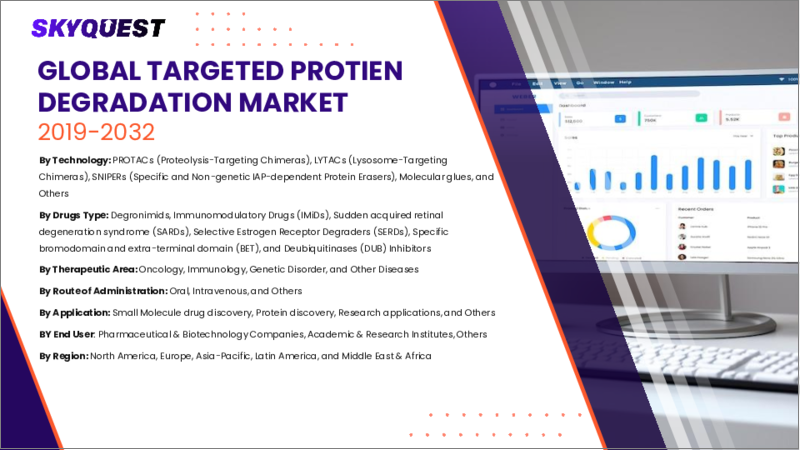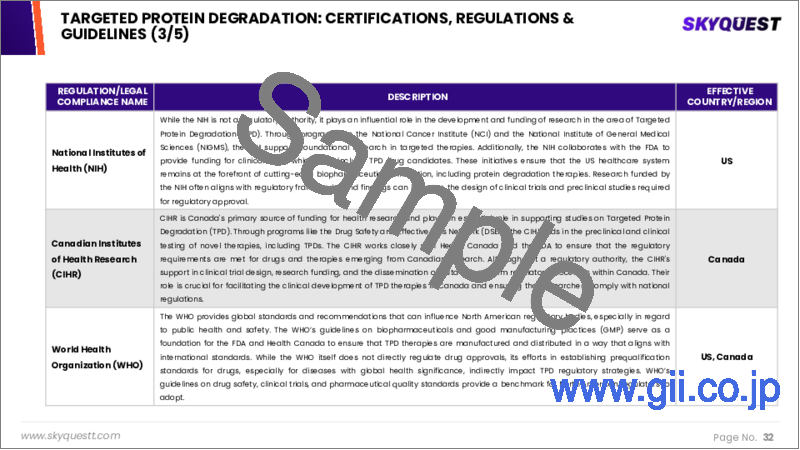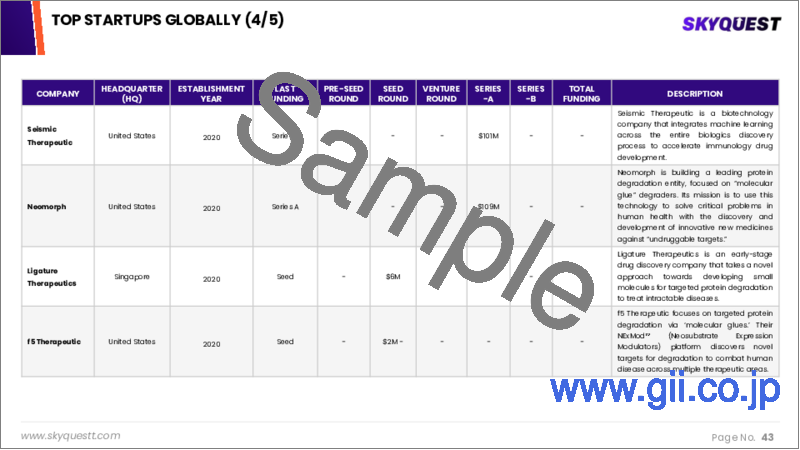|
|
市場調査レポート
商品コード
1622335
標的タンパク質分解の市場規模、シェア、成長分析:タイプ別、治療領域別、投与経路別、最終用途別、地域別 - 産業予測 2025~2032年Targeted Protein Degradation Market Size, Share, Growth Analysis, By Type (Degronimids, Immunomodulatory Drugs ), By Therapeutic Area, By Route of Administration, By End Use By Region - Industry Forecast 2025-2032 |
||||||
|
|||||||
| 標的タンパク質分解の市場規模、シェア、成長分析:タイプ別、治療領域別、投与経路別、最終用途別、地域別 - 産業予測 2025~2032年 |
|
出版日: 2024年12月21日
発行: SkyQuest
ページ情報: 英文 157 Pages
納期: 3~5営業日
|
全表示
- 概要
- 目次
標的タンパク質分解市場規模は2023年に6億4,085万米ドルと評価され、2024年の8億1,003万米ドルから2032年には52億7,811万米ドルに成長し、予測期間(2025~2032年)のCAGRは26.40%で成長する見通しです。
標的タンパク質分解(TPD)は、低分子を利用して有害なタンパク質を選択的に除去する画期的な医薬品開発戦略として注目を集めています。この革新的な方法は、従来「治療不可能」とされてきたタンパク質を含む様々な疾患への幅広い適用可能性など、従来のアプローチと比較して大きな利点を示しています。TPDの選択性はオフターゲット効果を最小化し、副作用を抑えながら治療効果を高める。さらに、TPD薬剤は持続性が高く、しばしば長期間にわたって効果を維持するため、投与回数が減り、患者のアドヒアランスが向上する可能性があります。その結果、情勢は、特にがんや遺伝性疾患のような複雑な疾患に対する新規治療法の開発に大きな可能性を秘めており、医薬品業界における有望なフロンティアとして位置づけられています。
目次
イントロダクション
- 調査の目的
- 調査範囲
- 定義
調査手法
- 情報調達
- 二次データと一次データの方法
- 市場規模予測
- 市場の前提条件と制限
エグゼクティブサマリー
- 世界市場の見通し
- 供給と需要の動向分析
- セグメント別機会分析
市場力学と見通し
- 市場概要
- 市場規模
- 市場力学
- 促進要因と機会
- 抑制要因と課題
- ポーターの分析
主な市場の考察
- 重要成功要因
- 競合の程度
- 主な投資機会
- 市場エコシステム
- 市場の魅力指数(2024年)
- PESTEL分析
- マクロ経済指標
- バリューチェーン分析
- 価格分析
標的タンパク質分解市場規模:タイプ別
- 市場概要
- デグロニミド
- 免疫調節薬(IMIDS)
- タンパク質分解標的キメラ分子(PROTACS)
- 突発性網膜変性症候群(SARDS)
- 選択的エストロゲン受容体分解薬(SERDS)
- その他
標的タンパク質分解市場規模:治療領域別
- 市場概要
- 炎症性疾患
- 神経疾患
- 腫瘍性疾患
- 呼吸器疾患
- その他
標的タンパク質分解市場規模:投与経路別
- 市場概要
- オーラル
- 静脈内
- その他
標的タンパク質分解市場規模:最終用途別
- 市場概要
- 製薬・バイオテクノロジー企業
- 学術調査機関
- 病院および臨床検査室
- その他
標的タンパク質分解市場規模
- 北米
- 米国
- カナダ
- 欧州
- ドイツ
- スペイン
- フランス
- 英国
- イタリア
- その他欧州地域
- アジア太平洋地域
- 中国
- インド
- 日本
- 韓国
- その他アジア太平洋地域
- ラテンアメリカ
- ブラジル
- その他ラテンアメリカ地域
- 中東・アフリカ
- GCC諸国
- 南アフリカ
- その他中東・アフリカ
競合情報
- 上位5社の比較
- 主要企業の市場ポジショニング(2024年)
- 主な市場企業が採用した戦略
- 市場の最近の動向
- 企業の市場シェア分析(2024年)
- 主要企業の企業プロファイル
- 会社概要
- 製品ポートフォリオ分析
- セグメント別シェア分析
- 収益の前年比比較(2022~2024年)
主要企業プロファイル
- Arvinas(USA)
- Kymera Therapeutics(USA)
- Nurix Therapeutics(USA)
- C4 Therapeutics(USA)
- Foghorn Therapeutics(USA)
- Zymeworks(Canada)
- Bristol-Myers Squibb(USA)
- Pfizer(USA)
- AbbVie(USA)
- Sanofi(France)
- Roche(Switzerland)
- AstraZeneca(UK)
- Vertex Pharmaceuticals(USA)
- Amgen(USA)
- Takeda Pharmaceutical(Japan)
- Novartis(Switzerland)
- Gilead Sciences(USA)
- Merck & Co.(USA)
- Janssen Pharmaceuticals(Johnson & Johnson)(USA)
- BeiGene(China)
結論と推奨事項
Targeted Protein Degradation Market size was valued at USD 640.85 Million in 2023 and is poised to grow from USD 810.03 Million in 2024 to USD 5278.11 Million by 2032, growing at a CAGR of 26.40% during the forecast period (2025-2032).
Targeted Protein Degradation (TPD) is gaining traction as a revolutionary drug development strategy, utilizing small molecules to selectively eliminate harmful proteins. This innovative method presents significant advantages over traditional approaches, including its broad applicability to various diseases, including previously deemed "undruggable" proteins. The selectivity of TPD minimizes off-target effects, enhancing therapeutic efficacy while reducing side effects. Moreover, TPD agents demonstrate increased durability, often remaining effective for extended periods, which may lead to less frequent dosing and improved patient adherence. As a result, targeted protein degradation holds immense potential for developing novel treatments, particularly for complex diseases like cancer and genetic disorders, positioning itself as a promising frontier in the pharmaceutical landscape.
Top-down and bottom-up approaches were used to estimate and validate the size of the Targeted Protein Degradation market and to estimate the size of various other dependent submarkets. The research methodology used to estimate the market size includes the following details: The key players in the market were identified through secondary research, and their market shares in the respective regions were determined through primary and secondary research. This entire procedure includes the study of the annual and financial reports of the top market players and extensive interviews for key insights from industry leaders such as CEOs, VPs, directors, and marketing executives. All percentage shares split, and breakdowns were determined using secondary sources and verified through Primary sources. All possible parameters that affect the markets covered in this research study have been accounted for, viewed in extensive detail, verified through primary research, and analyzed to get the final quantitative and qualitative data.
Targeted Protein Degradation Market Segmental Analysis
Global Targeted Protein Degradation Market is segmented by type, therapeutic area, route of administration, end use and region. Based on type, the market is segmented into degronimids, immunomodulatory drugs (IMIDS), proteolysis-targeting chimeric molecules (PROTACS), sudden acquired retinal degeneration syndrome (SARDS), selective estrogen receptor degraders (SERDS) and others. Based on therapeutic area, the market is segmented into inflammatory disorders, neurological disorders, oncological disorders, respiratory disorders and others. Based on route of administration, the market is segmented into oral, intravenous and others. Based on end use, the market is segmented into pharmaceutical & biotechnology companies, academic & research institutes, hospital & clinical laboratories and others. Based on region, the market is segmented into North America, Europe, Asia Pacific, Latin America and Middle East & Africa.
Driver of the Targeted Protein Degradation Market
The targeted protein degradation market is experiencing significant growth due to the increasing demand for more effective therapies for a range of diseases, particularly cancer, genetic disorders, and autoimmune conditions. There is a pressing need for treatments that address the root causes of these ailments, which heavily impact patient health and overall quality of life. Targeted protein degradation offers the promise of selectively eliminating disease-causing proteins, leading to more effective therapeutic outcomes with reduced side effects. By honing in on proteins implicated in various diseases, this innovative approach opens avenues for developing drugs that can treat previously unmanageable conditions, presenting new hope for patients who lack viable treatment alternatives.
Restraints in the Targeted Protein Degradation Market
The Targeted Protein Degradation market is hindered by inherent complexities that pose significant challenges to growth. This innovative approach necessitates an in-depth understanding of protein structure and function, as well as advanced skills in drug design and development. Creating new therapies in this arena is often a lengthy and intricate endeavor, which can impede progress. Targeted protein degradation aims to create drugs that selectively eliminate harmful proteins within cells by utilizing the body's natural degradation mechanisms, yet achieving this requires detailed knowledge of the disease biology and the implicated proteins. The design of effective, potent, and stable molecules further complicates the development process, demanding substantial investments in research and development.
Market Trends of the Targeted Protein Degradation Market
The targeted protein degradation market is witnessing a significant trend towards the development of oral drug formulations, catering to the demand for more patient-friendly therapies. This shift is largely driven by the need for convenience and improved compliance, as oral medications offer a practical alternative to traditional injection or infusion methods, minimizing the need for hospital visits. Pharmaceutical companies are heavily investing in R&D to create oral drugs that withstand digestive processes while effectively targeting disease pathways. These innovations promise sustained therapeutic effects and enhanced patient adherence, transforming the treatment landscape and elevating standards of patient care in the coming years.
Table of Contents
Introduction
- Objectives of the Study
- Scope of the Report
- Definitions
Research Methodology
- Information Procurement
- Secondary & Primary Data Methods
- Market Size Estimation
- Market Assumptions & Limitations
Executive Summary
- Global Market Outlook
- Supply & Demand Trend Analysis
- Segmental Opportunity Analysis
Market Dynamics & Outlook
- Market Overview
- Market Size
- Market Dynamics
- Drivers & Opportunities
- Restraints & Challenges
- Porters Analysis
- Competitive rivalry
- Threat of substitute
- Bargaining power of buyers
- Threat of new entrants
- Bargaining power of suppliers
Key Market Insights
- Key Success Factors
- Degree of Competition
- Top Investment Pockets
- Market Ecosystem
- Market Attractiveness Index, 2024
- PESTEL Analysis
- Macro-Economic Indicators
- Value Chain Analysis
- Pricing Analysis
Global Targeted Protein Degradation Market Size by Type & CAGR (2025-2032)
- Market Overview
- Degronimids
- Immunomodulatory Drugs (IMIDS)
- Proteolysis-Targeting Chimeric Molecules (PROTACS)
- Sudden Acquired Retinal Degeneration Syndrome (SARDS)
- Selective Estrogen Receptor Degraders (SERDS)
- Others
Global Targeted Protein Degradation Market Size by Therapeutic Area & CAGR (2025-2032)
- Market Overview
- Inflammatory Disorders
- Neurological Disorders
- Oncological Disorders
- Respiratory Disorders
- Others
- Global Targeted Protein Degradation Market Size by Route of Administration & CAGR (2025-2032)
- Market Overview
- Oral
- Intravenous
- Others
Global Targeted Protein Degradation Market Size by End Use & CAGR (2025-2032)
- Market Overview
- Pharmaceutical & Biotechnology Companies
- Academic & Research Institutes
- Hospital & Clinical Laboratories
- Others
Global Targeted Protein Degradation Market Size & CAGR (2025-2032)
- North America (Type, Therapeutic Area, Route of Administration, End Use)
- US
- Canada
- Europe (Type, Therapeutic Area, Route of Administration, End Use)
- Germany
- Spain
- France
- UK
- Italy
- Rest of Europe
- Asia Pacific (Type, Therapeutic Area, Route of Administration, End Use)
- China
- India
- Japan
- South Korea
- Rest of Asia-Pacific
- Latin America (Type, Therapeutic Area, Route of Administration, End Use)
- Brazil
- Rest of Latin America
- Middle East & Africa (Type, Therapeutic Area, Route of Administration, End Use)
- GCC Countries
- South Africa
- Rest of Middle East & Africa
Competitive Intelligence
- Top 5 Player Comparison
- Market Positioning of Key Players, 2024
- Strategies Adopted by Key Market Players
- Recent Developments in the Market
- Company Market Share Analysis, 2024
- Company Profiles of All Key Players
- Company Details
- Product Portfolio Analysis
- Company's Segmental Share Analysis
- Revenue Y-O-Y Comparison (2022-2024)
Key Company Profiles
- Arvinas (USA)
- Company Overview
- Business Segment Overview
- Financial Updates
- Key Developments
- Kymera Therapeutics (USA)
- Company Overview
- Business Segment Overview
- Financial Updates
- Key Developments
- Nurix Therapeutics (USA)
- Company Overview
- Business Segment Overview
- Financial Updates
- Key Developments
- C4 Therapeutics (USA)
- Company Overview
- Business Segment Overview
- Financial Updates
- Key Developments
- Foghorn Therapeutics (USA)
- Company Overview
- Business Segment Overview
- Financial Updates
- Key Developments
- Zymeworks (Canada)
- Company Overview
- Business Segment Overview
- Financial Updates
- Key Developments
- Bristol-Myers Squibb (USA)
- Company Overview
- Business Segment Overview
- Financial Updates
- Key Developments
- Pfizer (USA)
- Company Overview
- Business Segment Overview
- Financial Updates
- Key Developments
- AbbVie (USA)
- Company Overview
- Business Segment Overview
- Financial Updates
- Key Developments
- Sanofi (France)
- Company Overview
- Business Segment Overview
- Financial Updates
- Key Developments
- Roche (Switzerland)
- Company Overview
- Business Segment Overview
- Financial Updates
- Key Developments
- AstraZeneca (UK)
- Company Overview
- Business Segment Overview
- Financial Updates
- Key Developments
- Vertex Pharmaceuticals (USA)
- Company Overview
- Business Segment Overview
- Financial Updates
- Key Developments
- Amgen (USA)
- Company Overview
- Business Segment Overview
- Financial Updates
- Key Developments
- Takeda Pharmaceutical (Japan)
- Company Overview
- Business Segment Overview
- Financial Updates
- Key Developments
- Novartis (Switzerland)
- Company Overview
- Business Segment Overview
- Financial Updates
- Key Developments
- Gilead Sciences (USA)
- Company Overview
- Business Segment Overview
- Financial Updates
- Key Developments
- Merck & Co. (USA)
- Company Overview
- Business Segment Overview
- Financial Updates
- Key Developments
- Janssen Pharmaceuticals (Johnson & Johnson) (USA)
- Company Overview
- Business Segment Overview
- Financial Updates
- Key Developments
- BeiGene (China)
- Company Overview
- Business Segment Overview
- Financial Updates
- Key Developments





